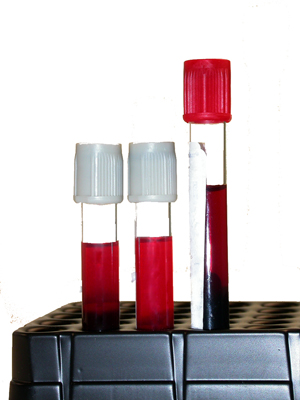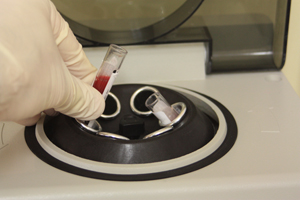Giving Patients TLC
Why Tender Loving Care Takes a Lot of Concentration
by Dennis Ernst • November 08, 2021
To most, the acronym “TLC” stands for "Tender Loving Care." But for phlebotomists and others who draw diagnostic blood samples, TLC can have several meanings.

Tubes Labeled Correctly – According to the Clinical and Laboratory Standards Institute (CLSI), every patient’s blood sample must be positively and permanently identified after the tube is filled (not before), and while at the patient’s side. At a minimum, the tube’s label should include the patient’s first and last names; identification number; date; time (as required); and the identity of the collector.
As a confirmation step, CLSI requires us to compare the labeled tube to the patient’s wristband or have the patient verify that the information on the tube is accurate. On the other hand, when labeling protocols are set aside for the sake of expediency, patient samples are at risk of becoming TLC: Tubes Lost in Chaos.
Tourniquet Loosened Conscientiously – Trained phlebotomists know that time restrictions accompany proper tourniquet application. When possible, loosen the tourniquet after blood flow is established to minimize the effects of hemoconcentration, which begins altering analyte concentration and inducing hemolysis within one minute. For those who practice prolonged tourniquet use, water and smaller molecules pass through the vessel wall into the tissues, leaving behind cells and larger compounds. Because of the disproportionate quantity of elements retained, samples drawn from hemoconcentrated veins may present an inaccurate picture of the patient’s true status to the physician.
Technique Lessens Carryover – Additive carryover isn't just a theory; it's documented to significantly impact test results. The order of draw does not eliminate additive carryover between different types of additive tubes, but it makes carryover irrelevant. The recommended order of draw is as follows:
- Blood culture tubes or vials
- Coagulation tube (e.g., blue stopper)
- Serum tube with our without clot activator, with or without gel (e.g., red stopper)
- Heparin tube with or without gel plasma separator (e.g., green stopper)
- EDTA tube with or without gel separator (e.g., lavender, pearl stopper)
- Glycolytic inhibitor (e.g., gray stopper)
- EDTA tubes (e.g., lavender stopper)
- Tubes with other additives (e.g., green stopper)
- Tubes without additives (e.g., red stopper)
Tracking the Location of Collection – What does your facility policy say about drawing blood from above or below active IV sites? Because of the potential for erroneous test results, avoid drawing blood from the same arm as fluids are being infused whenever possible. When not possible, CLSI recommends that a qualified caregiver shut off the IV for a minimum of two minutes prior to the draw. The limb (e.g., left or right arm) and location of the draw in relation to the IV site should be noted on the tube, with the information accompanying the patient’s test results. Such notations can prevent inappropriately adding tests to stored samples and supply valuable information to the clinician, should the results prove questionable.

Turbulence Lyses Cells – During vein selection, do you assess the patient’s unique physical characteristics, matching them to blood collection devices most suitable for the draw? You should. Smaller bore needles (e.g., 25-gauge) are best reserved for difficult draws and patients with small or fragile veins. That’s because with a higher gauge needle comes a higher risk of sample hemolysis due to the increased shear forces exerted on the red blood cells during collection, particularly when small-bore needles are used in combination with vacuum tube systems.
Team Lowers Contamination – A CDC Laboratory Medicine Best Practices initiative report reflects what many facilities already know: using a dedicated phlebotomy team for blood culture collections reduces blood culture contamination rates. The report also cites venipuncture as the preferred technique for blood culture collection. With a phlebotomy team, there’s less deviation from established procedures, such as repalpating a prepped site without recleansing. Experienced collectors know such departures from aseptic technique represent another type of TLC: Touching Leaves Contaminants.
Timely Laboratory Collections – Some tests must be collected at precise intervals due to medications, fasting requirements or biological variations. The accuracy of the result obtained is dependent upon the phlebotomist drawing the sample at the proper time. When monitoring therapeutic drug levels, the time of the last dose given, along with the time of specimen collection should be recorded on the test request or in the patient’s electronic record. If timed draws aren’t timely, then reported peak levels aren’t really peaks, and trough levels aren’t really baselines for the current dosage. When drug level results are compromised due to collector error, physicians may mismanage their patients by incorrectly adjusting medication therapy based on the faulty information received.
Tends to Lose Consciousness – Does your phlebotomy chair have armrests or a safety feature to prevent patients who pass out from falling? Do you have a place to recline patients who report a history of fainting (or near-faint experiences) during blood draws? Do you keep patients within your line of sight at all times while they are under your care? Do you have a means to summon assistance if a patient experiences an adverse reaction? CLSI states that phlebotomists should anticipate a possible loss of consciousness in their patients, and be prepared to act according to institutional policy.
Tests that Love Chilling – In order to obtain accurate results, some tests require special handling, such as those that call for chilling of the sample immediately after collection and throughout the preanalytical phase. Examples include gastrin, ammonia, lactic acid, catecholamines, pyruvate, and parathyroid hormone (PTH). CLSI also recommends the use of refrigerated centrifuges when processing such temperature-sensitive analytes.

Taking Liberties with Centrifugation– Do you centrifuge serum samples before they are fully clotted? If so, residual fibrin may be a recurrent problem. Using a wooden applicator stick to release the fibrin and whip the sample into shape only stirs up trouble, as rimming the tube can hemolyze the sample. To protect the integrity of the sample and avoid unnecessary manipulation, allow serum tubes to adequately clot prior to centrifugation, and spin tubes with their stoppers in place. Tubes Lacking Closures (TLC) during centrifugation may produce potassium results that are elevated as much as 135%. Keeping specimens capped also helps prevent sample contamination, aerosols, spills, and changes in concentration due to evaporation.
On the opposite end of the time spectrum, unless documented evidence exists that longer contact times do not affect test results, separate serum/plasma from cells as soon as possible. Another preanalytical liberty that shouldn’t be taken is recentrifuging tubes to obtain additional serum/plasma. When a tube is centrifuged a second time, the analyte concentration of the serum/plasma produced is altered and if tested, may yield inaccurate results.4 One study showed recentrifuging gel tubes a second time may increase potassium levels by 47%.
Training Leads to Consistency – When phlebotomists are properly trained, supervised, and oriented to the workplace, they have the best opportunity to perform their assigned tasks successfully and consistently. Assuring staff operates within the standard of care for phlebotomy also requires periodic TLC: Testing for Long-term Comprehension and direct observation of technical skills. Without initial and regular assessments of employee competence, TLC: Tricks Leading to Compromise of the procedure can creep in, jeopardizing collector and patient safety.
As a phlebotomist, are you delivering all the TLC you should in the workplace? From the patient’s perspective, when Trust, Listening, and Compassion (TLC) are infused into the collection process, quality care is delivered and customer satisfaction is high. For facilities, putting the right TLC in blood specimen collection helps avoid the dreaded TLC that may come with claims of medical malpractice: Trials and Lawsuits are Costly.
Related Posts and Information
overall rating: my rating: log in to rate
centrifugation centrifuge YouTube fainting hemoconcentration mixing order of draw pass out preanalytical revolutions per minute
57 Comments
pathology collector
that was great didnt knot you could use TLC for so many things related to Phlebotomy
Annette Barwick, 11/08/2021 16:18:19
Very good Article
Very good article as usual. As always, I will be sharing this with my other phlebotomy colleagues here in Kingston, Jamaica
Fitzloyd Beckford, 11/08/2021 17:51:57
MLA
HI, thanks for the informative posts. Wondering if citations can be included including those numbers like potassium levels mentioned in post? Thanks.
Jong Leu, 11/09/2021 10:47:40
phlebotomist
I always treat my pts as I would want to be treated with kindness and efficiency.
juanita easter, 11/10/2021 07:36:36
GIVING PTS TLC
TLC IS A MUST WHEN PERFORMING ANY MEDICAL PROCEDURE. I NOTICED NO DOB WAS MENTIONED FOR PT IDENTIFICATION
DIANE.B (MOBILE PHLEBOTOMIST), 12/30/2021 14:27:14
